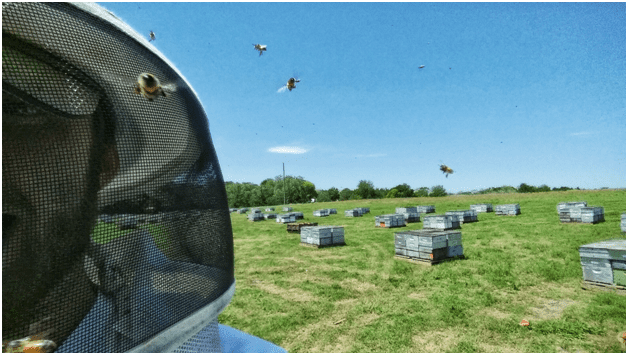A busy April…and, as always, a challenging month for weather
As we wait for the results from the almond bee bread samples taken in February and March, our teams are gearing up for a very busy season. It is always fascinating to follow crop pollination events, find out who is making splits, how queen production is faring and what weather patterns are either cooperating or wreaking havoc.
So far in April, both nosema and Varroa loads have remained low, averaging across all tech teams at 0.73 million spores/bee and 0.31 mites/100 bees respectively.
Here is the news from our tech teams across the country.
Texas:
Texas beekeepers are trying to weather the storm in East and Southeast Texas. The Houston area received up to 16 inches of rain within two days earlier this week, rain is still coming, and water levels still rising. Many people have been evacuated from their homes, and the governor of Texas has declared a state of emergency in 9 counties so far. We are all hoping that the bees (and everyone else) will stay safe and dry. The big push for splitting and re-queening colonies is pretty much completed here in Texas, and beekeepers are checking back on their queens and hoping to make a good honey crop this late spring and summer (if it ever dries out!).
California:
Northern California queen breeders are in the middle of grafting season and there has been good mating weather for the queens. There was a flash almond bloom this year which has caused the colonies to grow a little slower coming out of the orchards. Some colonies didn’t have time to collect a lot of pollen and others plugged out quickly and the queen ran out of room to lay. This has made it difficult to get enough bulk bees while shaking for packages, but things are catching up due to the abundance of mustard and other flowers.
Oregon:
Early spring weather has been favorable with warm and dry conditions accelerating cherry and pear blooms in the Columbia Gorge. As pollination of those crops is wrapping up many bees have been moved into blueberry fields in western Oregon. Beekeepers are also producing nucs and packages for distribution to the hobbyist market. The long range forecast is for a return to cooler conditions with some rain for the remainder of the month and into early May.
Minnesota:
An unseasonably warm spring is turning the plants green, with dandelions in full-on bloom around Minneapolis. Some beekeepers are in their winter locations in the deep south or the west applying treatments or doing check-backs to see if their queens we accepted, mated, and laying. Others are pollinating crops along the west coast. Others yet are bringing loads of bees back to the Midwest. The last spring frost generally occurs around May 23rd in Jamestown, ND, so there will be a few chilly days ahead.
Florida:
In Florida, a majority of the beekeepers have already treated for mites but some are just starting to treat before the Gallberry bloom. It has been colder than normal over the past month which has slowed the buildup of colonies. Beekeepers in areas with Tupelo are in high hopes for a good honey flow this year since there has not been a great flow in a number of years. Small hive beetle seems to be under control now but will persist in the fall, especially with weaker, struggling hives. Bears in northern Florida still threaten colonies, requiring beekeepers to make many round trips checking batteries in fenced apiaries.
